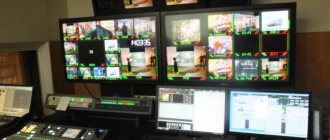In Russia, over the past few years, preparations have been in full swing for the transition to digital television and the abandonment of the old analogue one. This broadcasting system allows you to receive a high-quality picture even in remote settlements. The first regions connected to digital back in 2021. St. Petersburg and the Leningrad region were supposed to join them in the summer of 2019, but the regions were technically not ready.
There has been a transition to digital television in St. Petersburg and Leningrad Region from October 14, 2021. Latest news - some categories of citizens can receive compensation for the costs of purchasing a set-top box from the budgets of their regions.
Legal assistance:
Free in Russia: 8
Dear readers!
The free legal assistance hotline is available for you 24 hours a day!
When does analog TV stop in St. Petersburg?
According to the schedule, the transition from analogue to digital signal was carried out on February 11, 2021, April 15, 2021 and June 3, 2021. The supply of analogue broadcasting will be completely stopped in St. Petersburg and the Leningrad region on October 14, 2021. What are the benefits of watching digital channels:
- Twenty public digital channels in high quality are becoming free for all residents of Russia.
Based on an analog signal, this is impossible due to the high cost of its modernization and maintenance. An analog signal has a limited radio frequency resource. - For many Russians, the transition to new broadcasting means an end to information inequality and the opportunity to watch programs in high quality picture and sound.
- Transmitting a digital signal reduces the power of transmitters while increasing the signal's resistance to interference.
- Viewers have the opportunity to record programs for later viewing.
- And the main advantage is the complete absence of a subscription fee. Free viewing of the main public channels.
Connecting the set-top box
To connect the set-top box you need:
- Connect the antenna cable to the antenna inputs of the set-top box. Video and audio cables should be connected to the appropriate connectors of the set-top box and TV;
- turn on the TV;
- in the TV menu, set the receiving signal source: HDMI (best option), AV, SCART, etc.;
- turn on the auto-search function for channels: press info on the remote control and select auto-search in the channel settings - the system itself will find the necessary channels;
- The signal level should be at least 60%, or even better 70%, signal quality 100%.
Antenna setup
What to do if you are not satisfied with the image quality or the signal is unstable? If the image is scattered, it may be due to amplification. In this case you need to check:
- that the antenna is not placed near reflective shielding surfaces;
- there should be no power lines, other transmitting objects or other sources of interference nearby;
- so that neighbors do not have uncertified antennas.
Sometimes it may be unnecessary to boost the signal. If the tower has powerful transmitters, it may be more appropriate to use antennas without an amplifier. Try reducing the gain and check the image quality. If everything is in order, but the image remains of poor quality, try rotating the antenna while observing the quality of the picture. Perhaps a more effective solution would be to search for the source of the reflected signal - for example, pointing the antenna at the wall of a neighboring house.
The quality of the antenna also plays a role. Do not buy uncertified products: they may receive unstable signals due to poor quality assembly. If the antenna and the cable to it have already been used somewhere for some time, they may fail due to adverse weather conditions. Also check the quality of the antenna and cable connections.
Advantages of digital television
The transition to digital television in St. Petersburg is almost complete. Every resident of the northern capital and region can afford to watch digital media broadcasting without a subscription fee. Digital television has a number of advantages over cable and satellite:
- no subscription fee;
- cost of receiving equipment;
- possibility of independent installation of receiving equipment;
- Suitable for city houses and apartments and for country residences.
When will St. Petersburg switch to digital television? This question is no longer relevant. The transition took place on June 3, 2021. And either avid summer residents and vacationers, or owners of cable or satellite television could have missed this moment. Therefore, if you returned from a long vacation and your TV stopped receiving channels, just retune it to digital.
5 / 5 ( 2 voices)
Connecting to a new type of broadcasting standard DVB-T2
Recommendations for connecting digital television were approved by the Government of the Russian Federation by Order No. 287-r and by the decision of the State Commission dated March 16, 2012.
The digital signal in Russia is carried out in the DVB-T2 format. The DVB-T2 standard is one of the latest generations of the European type of broadcasting terrestrial television DVB-T. In this standard, the capacity of terrestrial television networks is increased by 30 percent.
To connect digital broadcasting, no special skills or knowledge are required . Setting up equipment to receive the signal will not take much time.
What is required to connect digital television in St. Petersburg
To receive digital free television you will need a UHF antenna. In all TVs released after 2012. The signal is supported in the DVB-T2 standard. This is where free multiplexes are broadcast. Modern TVs are equipped with a built-in DVBT2 tuner. The TV receiver allows you to use auto search to find from 11 to 20 digital TV channels. For older TVs, you will need to purchase a digital set-top box.
If you can purchase almost any set-top box for receiving a digital signal, then the choice of antenna depends on the degree of distance from the television tower:
- If the house is located at a distance of 3-10 km from the TV tower, and the apartment is on the top floor, the signal can be received even using an indoor antenna. If the TV tower is obscured, an outdoor antenna can be installed on the roof.
- If the distance to the TV tower is 10-30 km, you will need an outdoor antenna with an amplifier on the roof. If the apartment is located on the upper floors of a multi-story building, an antenna installed outside the window may be sufficient.
- In all other cases, you will need an external antenna with an amplifier directed towards the television tower.
What you need for this: equipment
New TVs released after 2012 receive a new signal with an antenna. The antenna can be of internal or external type. The antenna can also be collective or individual. TVs manufactured after 2012 have a built-in DVB-T2 tuner that allows you to receive a digital signal.
- On a device with a built-in tuner, you can configure 10 or 20 digital public channels through auto channel search.
- For television receivers in which the DVB-T2 tuner is not initially built-in, you will need, in addition to the antenna, to connect a digital receiver. The set-top box will decode the signal for transmission to the TV.
- Ancient Soviet televisions will not be able to receive this signal, even with the help of additional equipment. An additional set-top box is connected via a tulip connector, which is not available on Soviet TVs.
How to connect it?
Many companies offer services for connecting additional equipment for broadcast reception. But anyone can set up the antenna and set-top box by following step-by-step instructions.
Antenna installation and configuration
- Please read the instructions carefully before installation.
- Check the location and procedure for connecting the antenna to the television receiver.
Don't forget to purchase a cable with characteristic impedance. Recommended value 75 Ohm. - Find out where the nearest tower is located and point the antenna in that direction.
- Using auto tuning, start searching for channels. If the channels are not tuned in, start manual tuning.
- You can adjust the signal quality level by rotating the antenna.
Focus on the signal intensity and quality scale.
What can be done if the antenna signal is not stable:
- First, check to see if there were any short-term signal outages.
- If your neighbors have a digital signal, check your device's connections - antenna and cable.
- If no one has a signal, report the information to the hotline. Temporary problems may occur.
If the image is blurry, check that the amplifier on the antenna is turned on. Near a tower, having the amplifier turned on may reduce or change the picture quality due to the strong antenna signal. It is necessary to turn off the amplifier or reduce the gain slightly.
Do not install antennas of unknown manufacture; purchase them only with technical documents.
How to install the console?
- Before installing the set-top box, disconnect the TV from the network.
- Connect the antenna to the set-top box.
- Insert the cable into the audio and video connectors on the set-top box and TV set.
- Connect the equipment to the network and turn it on.
- Select the input signal type from the TV menu. The signal source can be designated as HDMI, AV, SCART.
- Use auto tuning to search for channels. If you are unable to configure the channels, start manual tuning.
Please refer to the instruction manual.
How to set your TV to digital?
To configure your TV to digital, you should consider the basic circuit for all TV receivers. In different models and from different manufacturers, the sequence of actions and names of setting items may differ.
Basic algorithm:
- Enter the TV menu using the remote control.
- Select "Options" - "Auto setup".
- Signal source – “Cable”.
- Click “Start”.
- Source: Digital.
- Click “Start”.
- In the “Search Mode” item, select “Full”.
When connecting digital TV in St. Petersburg, you should remember that there are TV models that require additional cable search parameters. In this case, enter:
- Frequency (kiloHertz) - 314,000 (314 MHz).
- Modulation - 256 QAM.
- Transmission speeds - 6875 kS/s.
Tuning your TV to a new broadcast will not cause problems if you follow the product operating instructions.
How to set up digital TV
All TVs released after 2013 support the DVB-T2 standard. Owners of such TVs have nothing to worry about. You can set up digital television yourself without leaving your home. To do this, you need to go to the TV menu, turn on the digital tuner and the channel tuning function. After this, digital television should work.
It is more difficult to switch to digital if the TV does not support the DVB-T2 standard. Many TV models released before 2013 were like this, as well as older models with a picture tube. They require a set-top box with a built-in DVB-T2 antenna. The cost of such a set-top box ranges around 600 rubles. – 1500 rub. You can buy it in household appliance stores or at Russian Post offices.
In addition to the set-top box, you may also need an antenna. But not everyone will need it to make the transition to digital television in St. Petersburg in 2021. What needs to be done to avoid having to buy an additional antenna? First of all, determine how the signal enters the house:
- if a collective antenna is installed in the house, then the responsibility for installing and working with new digital television lies with the management company or HOA. They are responsible for ensuring that residents’ televisions, when properly configured, can receive digital television.
- If cable television is connected, then the cable television operator is responsible for the transition to digital. They do all the necessary work themselves.
- If the satellite dish works, then the TV should also work with digital broadcasting.
It’s a little more difficult for residents of remote settlements, as well as owners of country houses. To receive the required signal, you need a UHF antenna aimed at the nearest RTRS television tower. The antenna must be of the decimeter range (UHF). If the TV viewer now receives a signal in the meter range (VHF), then it is necessary to select a suitable UHF antenna and update the antenna cable.
Despite the need to purchase an antenna in certain cases, the main expenses of the population fall precisely on the purchase of set-top boxes for older TV models. But for their purchase, some categories of citizens can receive compensation for the costs of digital television in St. Petersburg in 2021.
How to refuse a radio point in St. Petersburg and Moscow in 2019?
Frequency table for the northern capital and Leningrad region
Let's look at what frequencies the new type of broadcasting operates in St. Petersburg. The tables provide a complete list of 20 broadcasting channels in St. Petersburg and the Leningrad region. For convenience, the television channel number and its frequency are indicated.
First Multiplex
| Name | TVK number and frequency (MHz) |
| First channel | №35 (586) |
| Russia 1 | №35 (586) |
| Match TV | 35 (586) |
| NTV | 35 (586) |
| Channel 5 | 35 (586) |
| Russia K | 35 (586) |
| Russia 24 | 35 (586) |
| Carousel | 35 (586) |
| OTR | 35 (586) |
| TV Center | 35 (586) |
Second Multiplex
| Name | TVK number and frequency (MHz) |
| Ren TV | 45 (666) |
| Saved | 45 (666) |
| STS | 45 (666) |
| Home | 45 (666) |
| TV-3 | 45 (666) |
| Friday | 45 (666) |
| Star | 45 (666) |
| World | 45 (666) |
| TNT | 45 (666) |
| Muz TV | 45 (666) |
Complete analogue television shutdown table
It is worth noting that the transition to digital is a thoughtful process that, thanks to a competent approach, will allow subscribers to enjoy higher quality images when watching their favorite programs, TV series and films. So turning off the analog signal is a big step.
Below you can see a schedule for switching off analogue television for different regions of the country. You can find your area if necessary and by then check whether your TV model supports digital.
| No. | Stage | Date of termination of analogue broadcasting | Region |
| 1 | 0 | December 03, 2021 | Tver region |
| 2 | I | February 11, 2021 | Magadan Region |
| 3 | I | February 11, 2021 | Penza region |
| 4 | I | February 11, 2021 | Ryazan Oblast |
| 5 | I | February 11, 2021 | Tula region |
| 6 | I | February 11, 2021 | Ulyanovsk region |
| 7 | I | February 11, 2021 | Chechen Republic |
| 8 | I | February 11, 2021 | Yaroslavl region |
| 9 | II | April 15, 2021 | Amur region |
| 10 | II | April 15, 2021 | Ivanovo region |
| 11 | II | April 15, 2021 | Kabardino-Balkarian Republic |
| 12 | II | April 15, 2021 | Karachay-Cherkess Republic |
| 13 | II | April 15, 2021 | Kemerovo region |
| 14 | II | April 15, 2021 | Kirov region |
| 15 | II | April 15, 2021 | Kostroma region |
| 16 | II | April 15, 2021 | Kurgan region |
| 17 | II | April 15, 2021 | Lipetsk region |
| 18 | II | April 15, 2021 | Moscow |
| 19 | II | April 15, 2021 | Moscow region |
| 20 | II | April 15, 2021 | Novgorod region |
| 21 | II | April 15, 2021 | Republic of Kalmykia |
| 22 | II | April 15, 2021 | The Republic of Mordovia |
| 23 | II | April 15, 2021 | Sakhalin region |
| 24 | II | April 15, 2021 | Stavropol region |
| 25 | II | April 15, 2021 | Tyumen region |
| 26 | II | April 15, 2021 | Udmurt republic |
| 27 | II | April 15, 2021 | Chuvash Republic |
| 28 | II | April 15, 2021 | Yamalo-Nenets Autonomous Okrug |
| 29 | III | June 03, 2021 | Altai region |
| 30 | III | June 03, 2021 | Arhangelsk region |
| 31 | III | June 03, 2021 | Bryansk region |
| 32 | III | June 03, 2021 | Vladimir region |
| 33 | III | June 03, 2021 | Voronezh region |
| 34 | III | June 03, 2021 | Jewish Autonomous Region |
| 35 | III | June 03, 2021 | Irkutsk region |
| 36 | III | June 03, 2021 | Kaliningrad region |
| 37 | III | June 03, 2021 | Kamchatka Krai |
| 38 | III | June 03, 2021 | Krasnodar region |
| 39 | III | June 03, 2021 | Krasnoyarsk region |
| 40 | III | June 03, 2021 | Nenets Autonomous Okrug |
| 41 | III | June 03, 2021 | Nizhny Novgorod Region |
| 42 | III | June 03, 2021 | Novosibirsk region |
| 43 | III | June 03, 2021 | Omsk region |
| 44 | III | June 03, 2021 | Oryol Region |
| 45 | III | June 03, 2021 | Perm region |
| 46 | III | June 03, 2021 | Primorsky Krai |
| 47 | III | June 03, 2021 | Republic of Adygea |
| 48 | III | June 03, 2021 | The Republic of Buryatia |
| 49 | III | June 03, 2021 | Komi Republic |
| 50 | III | June 03, 2021 | Mari El Republic |
| 51 | III | June 03, 2021 | The Republic of Sakha (Yakutia) |
| 52 | III | June 03, 2021 | Republic of North Ossetia-Alania |
| 53 | III | June 03, 2021 | Republic of Tatarstan |
| 54 | III | June 03, 2021 | Tyva Republic |
| 55 | III | June 03, 2021 | The Republic of Khakassia |
| 56 | III | June 03, 2021 | Rostov region |
| 57 | III | June 03, 2021 | Samara Region |
| 58 | III | June 03, 2021 | Sverdlovsk region |
| 59 | III | June 03, 2021 | Smolensk region |
| 60 | III | June 03, 2021 | Tambov Region |
| 61 | III | June 03, 2021 | Tomsk region |
| 62 | III | June 03, 2021 | Khabarovsk region |
| 63 | III | June 03, 2021 | Khanty-Mansiysk Autonomous Okrug |
| 64 | III | June 03, 2021 | Chukotka Autonomous Okrug |
| 65 | IV | October 14, 2021 | Astrakhan region |
| 66 | IV | October 14, 2021 | Belgorod region |
| 67 | IV | October 14, 2021 | Volgograd region |
| 68 | IV | October 14, 2021 | Vologda Region |
| 69 | IV | October 14, 2021 | Saint Petersburg |
| 70 | IV | October 14, 2021 | Transbaikal region |
| 71 | IV | October 14, 2021 | Kaluga region |
| 72 | IV | October 14, 2021 | Kursk region |
| 73 | IV | October 14, 2021 | Leningrad region |
| 74 | IV | October 14, 2021 | Murmansk region |
| 75 | IV | October 14, 2021 | Orenburg region |
| 76 | IV | October 14, 2021 | Pskov region |
| 77 | IV | October 14, 2021 | Altai Republic |
| 78 | IV | October 14, 2021 | Republic of Bashkortostan |
| 79 | IV | October 14, 2021 | The Republic of Dagestan |
| 80 | IV | October 14, 2021 | The Republic of Ingushetia |
| 81 | IV | October 14, 2021 | Republic of Karelia |
| 82 | IV | October 14, 2021 | Republic of Crimea |
| 83 | IV | October 14, 2021 | Saratov region |
| 84 | IV | October 14, 2021 | Sevastopol |
| 85 | IV | October 14, 2021 | Chelyabinsk region |
How many programs will be available in St. Petersburg for free: complete list
20 federal channels become available and free for every resident of the Russian Federation.
First multiplex:
- First channel.
- Russia is one.
- NTV.
- Match TV.
- Channel 5.
- Russia K.
- Russia 24.
- OTR.
- Carousel.
- TV Center
Second multiplex:
- Ren TV.
- STS.
- Saved.
- Home.
- TV-3.
- Friday.
- Star.
- World.
- TNT.
- Muz TV.
This is public television in DVB-T2 format.
There is another option for high definition television. This is digital cable television. Cable television is also provided if the TV can receive a DVB-T2 signal. If digital broadcasting allows you to watch 20 publicly available channels, then cable broadcasting allows you to watch about 200. The list of channels on cable broadcasting is constantly growing.
By cost in St. Petersburg and the Leningrad region:
- Terrestrial television costs approximately 150 rubles per month for using a public antenna provided by Rostelecom.
- Using cable television will cost approximately 200 rubles per month. In this case, the number of channels will be many times higher.
When connecting to cable television, you can refuse to use the Rostelecom communal antenna. To do this, you need to write an application at any office of the company.
Current
ATTENTION! The transition to digital has been extended until October 14
—————-
In October 2021, analogue broadcasting of all-Russian mandatory public terrestrial television channels will cease in St. Petersburg and the Leningrad Region. Broadcasting will completely switch to digital format.
Cable and satellite television operators will continue broadcasting in accordance with agreements concluded with television viewers or HOAs/housing societies.
How can I check what signal my TV is receiving and should I worry about analogue terrestrial TV turning off?
Turn on the TV and look at the logo of one of the federal channels (for example, Channel One, Rossiya-1, NTV, Channel Five, Ren TV, STS). Analog terrestrial channel o. If there is no letter “A” next to the logos of TV channels, the viewer does not need to worry about turning off analogue broadcasting: this means that the viewer either already watches digital terrestrial television, or is a subscriber of a cable or satellite operator and does not need to purchase any additional equipment
If you see the letter “A” next to the logos of federal channels, but your TV receives 40 or more channels, it means you are watching cable television and you need to contact the cable operator or the Management Company/HOA of your home to clarify the reason for broadcasting the channels with the letter “A”, and also make sure that the broadcast of all federal channels will be continued by the cable operator after June 03, 2021. Additional equipment, if you watch cable television, does not need to be purchased.
If you see the letter “A” next to the logos of federal channels and at the same time receive no more than 19 TV channels, this means that you are watching a TV set to receive analogue terrestrial TV channels, which will be turned off on June 3, 2021. You need to configure your TV to receive digital terrestrial television: some TVs can be easily reconfigured, but for some you will additionally have to purchase a special digital set-top box.
To receive a digital signal, you need a TV that supports the DVB-T2 standard. Support for this standard is included in almost all TVs produced since 2013. You can check whether the TV supports the DVB-T2 standard both in the instructions for the TV and on the SMOTRITSIFRU.RF website (in the “Everything for reception” section there is a list of 26,796 TV models, 8,104 of which support the required digital standard).
For TVs released before 2013 and not supporting the DVB-T2 standard, you will need a digital set-top box of the same standard. A list of digital set-top boxes can also be found on the website SMOTRICIFRU.RF. Such set-top boxes can be purchased at all electronics and household appliance stores.
Also, to receive digital terrestrial television you will need a decimeter antenna. In an apartment building, most apartments require connection to a collective building-wide terrestrial antenna - SKPT (collective television reception system). Due to the fact that the SKPT is part of the common property of an apartment building, all information (about the presence of the SKPT, about its technical parameters - it must be a UHF antenna - about the condition, about the company that maintains the SKPT and connects to it) is located or in the Management Company servicing this apartment building, or in the board of the HOA. To obtain information about the availability of SKPT and connect to it, residents of apartment buildings must contact the Management Company or the board of the HOA of their apartment building. If there is no SKPT in the house, residents have the right to contact the management company/homeowners association with a request to restore the collective antenna.
In some cases - in apartments located on the upper floors of multi-apartment residential buildings, and provided that the television tower located on Aptekarsky Island is in direct line of sight, it is possible to receive CETV with an indoor antenna. In this case, the indoor antenna must be directional in the decimeter range. The indoor antenna should be located near the window. Reception of a signal on an indoor antenna with other parameters, as well as in the presence of physical interference in the direct line of sight (higher buildings, trees, etc.) is not guaranteed.
After connecting to digital terrestrial television, residents will have access to 20 digital TV channels of the first and second multiplexes, as well as three radio channels.
First multiplex: Channel One, Rossiya 1, Match TV, NTV, Channel Five, Rossiya Culture, Rossiya 24, Karusel, OTR and TV Center.
Second multiplex: Ren TV, Spas, STS, Domashny, TV-3, Friday, Zvezda, Mir, TNT and Muz-TV.
Radio channels – “Vesti FM”, “Mayak”, “Radio Russia”.
You can also find out more about digital terrestrial television on the website SMOTRICIFRU.RF or by calling the federal free 24-hour hotline 8-800-220-20-02.
On issues related to the transition to digital terrestrial broadcasting, including in terms of providing low-income citizens with compensation for the costs of purchasing and connecting user equipment for receiving digital terrestrial television signals, as well as on issues of obtaining advisory and organizational assistance for the acquisition and installation of equipment for receiving digital terrestrial television broadcasting, you can call the regional toll-free hotline 081.
Page created: 03/27/2019
How to switch to 57 Rostelecom programs?
Rostelecom informed its subscribers about the open access of 57 digital channels.
From November 1, 2021, Rostelecom subscribers can receive 57 broadcast channels on their devices. All Rostelecom digital channels are broadcast at no additional cost. The broadcast is carried out through a cable previously laid in a residential area . No additional equipment is required. All you need is retuning on all TVs in the apartment.
The TV receiver must accept the DVB-C standard.
- Select Cable channels from the menu.
- Launch "Auto Setup".
- Select "Cable TV/DVB-C".
- Operator Rostelecom.
- Select Digital.
Specify - skip encrypted programs. - Click "Get Started."
If all actions are performed correctly, 57 digital television channels should be tuned in.
Free help from specialists
If the digital signal has not been configured, then after turning off the analog channels, a message will appear on their frequency indicating the need to connect a new broadcast.
- If you have questions when connecting digital broadcasting, or when selecting and setting up additional equipment, you can call the toll-free hotline number: 8-800-220-2002. Specialists can provide assistance around the clock.
- Consultation can be given by calling 081 for operators Rostelecom, Megafon, Tele 2 or by calling the regional hotline 246-80-81.
- You can contact the Consulting Support Center of the St. Petersburg branch of RTRS: e-mail
- Frequently asked questions and answers on the topic of digital television are discussed on the official website of RTRS.RF in the “For TV Viewers” section.
- More detailed information on how to set up digital channels yourself can be read on the website SMOTRICIFRU.RF.
After considering the benefits of digital television, it becomes clear that the digital signal is the future of television broadcasting. By following the instructions and simple tips, anyone can set up broadcasting digital channels on their TV without the help of specialists.










